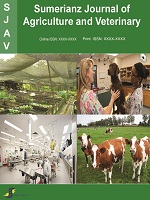Sumerianz Journal of Agriculture and Veterinary

Online ISSN: 2617-3077
Print ISSN: 2617-3131
Quarterly Published (4 Issues Per Year)
Journal Website: https://www.sumerianz.com/?ic=journal-home&journal=30Archive
Volume 3 Issue 3 (2020)
Effects of the Presence of the African Mistletoe Tapinanthus Bangwensis [Engl. and K. Krause] Danser on the Mineral Nutrient Composition Leaf Chlorophyll and Relative Water Content of Citrus Sinensis and Irvingia Gabonensis Host Plants
Authors : Edagbo D. E. ; Oyetunji O. J.
Abstract:Background: Information on the African Mistletoes with the focus on their interactions with host plants in view of the physiological and biochemical processes underlying the relationship is scanty. It is therefore necessary to engage in further study of the process for in-depth knowledge. Experiment: The stems and leaves of the mistletoe on Citrus and Irvingia plants and their hosts’ stems and leaves were collected, cleaned and dried in the sun. The dried materials were ground into powder and subjected to mineral analysis test. Tests were also conducted on fresh leaf samples for chlorophyll and relative water contents. Results: Mineral nutrients such as Na, K, Mg, N, Zn, Mn were significantly higher in the uninfested hosts when compared with infested in both Citrus sinensis and Irvingia gabonensis but the mineral nutrients contained in the parasite were in preponderance to that available in the infested. Leaf chlorophyll (chl) study revealed the possession of higher chlorophyll a and b content in the uninfested (chl a 41.11, b 37.29 mg/ml Cs; chl a 49.70, b 45.81 mg/ml Ig) when compared with infested (chl a 37.09, b 33.18 mg/ml Cs; chl a 46.65, b 41.99 mg/ml Ig) hosts; however comparative chlorophyll contents of the mistletoe to both hosts varied. Estimation of percentage Relative Water Content (RWC) of leaves during the season of dry (ds) and rainy (rs) conditions were higher for the infested (ds 83.07 rs 90.61 Cs; ds 89.25 rs 94.83 Ig) compared to uninfested (ds 81.81 rs 87.65 Cs; ds 75.09 rs 92.89 Ig) hosts while the mistletoe (ds 90.23 rs 95.08) exhibited comparative higher RWC to the hosts. Conclusion: The physiological relationship between the mistletoe and its hosts often led to diminished nutrients and chlorophyll content with acquisition of increased RWC in the infested hosts. The increased RWC implied a physiological process for water use efficiencies in Citrus sinensis and Irvingia gabonensis.



